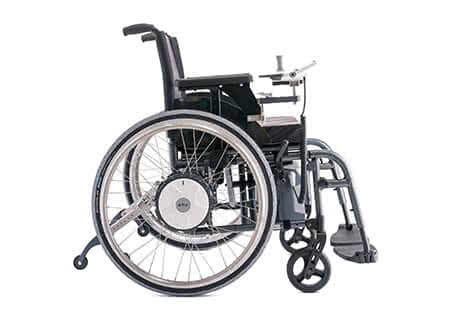Medicare Justification for the power-assist e-motion
E0986 MANUAL WHEELCHAIR ACCESSORY, PUSH ACTIVATED POWER ASSIST
e-motion push rim activated power assist medical justification reimbursement overview:
Based on e-motion’s unique and innovative features, SADMERC created a billing code - E0986 - Manual Wheelchair Accessory, Push Activated Power Assist effective January 1, 2004. e-motion push rim activated power assist has been successfully funded by Medicare/Medicaid, insurance companies and man-aged care organizations. The e-motion is often a least costly alternative to a power wheelchair.
Why consider a power assist?
- The e-motion provides a less stressful means of self propulsion for manual wheelchair users who need to protect and preserve their upper body strength and function required for progressive conditions and long-term use.
- It provides a more functional and less expensive options to a power wheelchair for people who still have some ability in pushing a manual wheelchair. Without the addition option of the e-motion power assist wheels, they will not be able to perform their MRADLs within the home.
- The e-motion provides the ability to be more independent and safe while negotiating inclines, declines, ramps etc. without assistance. Travel longer distances compared to a manual wheelchair.
Medicare Criteria for Power Assist:
A push-rim activated power assist device (E0986) for a manual wheelchair is covered if all of the following criteria are met:
- All the criteria for a power mobility device listed in the Basic Coverage Criteria sections are met; and
- The patient has been self-propelling in a manual wheelchair for a least one year; and
- The patient has had a specialty evaluation that was performed by a licensed/certified medical professional, such as a PT or OT, or physician who has specific training and experience in rehabilitation wheelchair evaluations and that documents the need for the device in the patient’s home. The PT, OT or physician may have no financial relationship with the supplier; and
- The wheelchair is provided by a supplier that employs a RESNA-certified Assistive Technology Professional (ATP) who specializes in wheelchairs and who has direct, in-person involvement in the wheelchair selection for the patient.
Suggestions to Include for Justification for Power Assist:
- Clients is having difficulty propelling his manual wheelchair which is preventing him to get ready for work in the morning and then having enough energy to complete his care needs at the end of the day.
- His shoulder pain is 7/10 during manual propulsion and he requires multiple rest breaks that delay him completing tasks
- Decreased force required for propelling and the use of power assist will reduce his pain and allow him more efficiency in morning ADL’s. It will also conserve his energy so he can participate in his family needs at the end of the day.
- Adjustments to his chair have been made with no change his manual wheelchair access. A full power chair is not necessary at this time.
- With the addition of power activated power assist wheel, the client will be able to more efficiently complete his morning ADL’s and return to a reliable work schedule as well as have enough endurance at the end of the day to participate in daily activities.
- Without the use of the PAPAW, access to work and his daily needs will be at risk: DO..., Focus on in home activities, Focus on how the equipment has changed their participation, Use measurable explanations (reports 3/5 shoulder pain), Recognize the endurance participant has at the end of the day
Please see these sample letters of medical necessity:
LETTER OF MEDICAL NECESSITY 1
LETTER OF MEDICAL NECESSITY 2
LETTER OF MEDICAL NECESSITY 3
LETTER OF MEDICAL NECESSITY 4
Power Assist Referrences:
LCD (Local Coverage Determination) information for Powered Mobility Devices
Clinical Practice Guidelines:
Preservation of Upper Limb Functioning in Spinal Cord Injury www.pva.org
- Published in 2005
- A consortium of professional including practitioners, researchers, and educators
- Consolidates research findings and relates them directly to clinical practice
- 35 recommendations in 6 specific categories
Please see the Preservation of Upper Limb Function Guides:
PVA Upper Limb Preservation Consumer Guide
PVA Upper Rim Preservation Professional Guide


